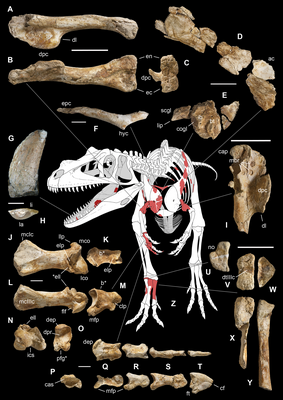Saltriovenator
| Saltriovenator | ||||||||||
|---|---|---|---|---|---|---|---|---|---|---|

Found fossils of Saltriovenator and reconstruction |
||||||||||
| Temporal occurrence | ||||||||||
| Lower Jurassic ( Sinemurian ) | ||||||||||
| 199.3 to 190.8 million years | ||||||||||
| Locations | ||||||||||
| Systematics | ||||||||||
|
||||||||||
| Scientific name | ||||||||||
| Saltriovenator | ||||||||||
| Dal Sasso , Maganuco , Cau , 2018 | ||||||||||
| species | ||||||||||
|
||||||||||
Saltriovenator zanellai (hunter from Saltrio plus the last name of the first discoverer) is a medium-sized theropod from the group of Ceratosauria foundin Italy .
description
Saltriovenator was found in northern Italy, in the province of Varese , near the municipality of Saltrio in the Saltrio formation , which can be assigned to the Sinemurian ( Lower Jurassic ). The fossil hunter Angelo Zanella found the first bones in 1996. The name was given in 2001 by Dalla Vecchia and refers to the nickname “saltriosaur” previously given by Cristiano Dal Sasso, which refers to the formation in which the animal was found . About 10% of the skeleton of the only known specimen ( MSNM V3664) is present. This surrounds a lateral tooth (45 mm long), ribs - and shoulder blade fragments , a clavicle , humerus ( humerus ), metacarpal (metacarpals) - and finger bones (phalanxes), as well as other parts of the hand, a fibula and other (all in all it prepares 132 bones). The length of Saltriovenator is estimated to be 8 meters. The finds are in Milan's natural history and natural history museum, the Museo Civico di Storia Naturale di Milano .
Paleohabitat
Saltriovenator lived in the Jurassic Age , which is often viewed as the time when Europe was largely inundated by the Tethys . However, according to Dal Sasso, this is wrong , at least for the Saltriovenator habitat . In his opinion, such a large animal could not survive on small islands because of its food needs. Since he suspects that Saltriovenator had to be at the head of a complex and terrestrial food chain , he assumes that there was still a connection between Laurasia and Gondwanaland in the Lower Jura, which could explain the existence of such animals.
Systematics
The exact systematic position of Saltriovenator was initially uncertain. At the beginning only the classification in the Theropoda group was relatively certain. Dal Sasso assigned Saltriovenator to the tetanurae due to the presence of a fork bone . Later he also thought it possible that Saltriovenator was a carnosaur . Benson saw Dal Sasso's reasoning as questionable. In his opinion, it could also be a member of the coelophysoid . After all, these also have fork legs. The completed preparation of the finds allow a classification into the four-fingered Ceratosauria . According to Simone Maganuco, paleontologist at the Milan Museum, the animal was not yet fully grown and allows new conclusions to be drawn about its development towards the three-fingered theropod.
Web links
Individual evidence
- ↑ a b Cristiano Dal Sasso, Simone Maganuco, Andrea Cau: The oldest ceratosaurian (Dinosauria: Theropoda), from the Lower Jurassic of Italy, sheds light on the evolution of the three-fingered hand of birds. PeerJ 6: e5976, doi: 10.7717 / peerj.5976 .
- ^ A b c Matthew T. Carrano, Roger BJ Benson, Scott D. Sampson: The phylogeny of Tetanurae (Dinosauria: Theropoda). In: Journal of Systematic Palaeontology. Volume 10, No. 2, 2012, ISSN 1477-2019 , pp. 211-300, here p. 262, doi: 10.1080 / 14772019.2011.630927 .
- ^ A b Cristiano Dal Sasso : Dinosauri italiani. Marsilio Editori, Venezia 2001, ISBN 88-317-7554-5 .
- ↑ a b c d Laura Geggel: “Miracle” Dinosaur Whose Bones Survived Being Blown Up Discovered in Italian Alps and Photos: Carnivorous Dinosaur Discovered in Italian Alps , both published December 19, 2018 on livescience.com, accessed December 20, 2018 .
- ↑ Cristiano Dal Sasso: A new theropod dinosaur from the Lower Jurassic of Italy, Saltriosaurus. In: Dino Press. Volume 3, 2001, ZDB -ID 2639108-9 , pp. 81-87.
- ↑ a b c Cristiano Dal Sasso: Update on Italian dinosaurs. In: 6th European Workshop on Vertebrate Palaeontology. Florence and Montevarchi (Italy). September 19-22, 2001. Abstract Volume. The University of Florence, Florenz 2001, p. 27, digilander.libero.it digitalisat (PDF; 358 kB).
- ↑ a b The Theropod Database, Saltriosaurus ( Memento from September 29, 2013 in the Internet Archive )
- ↑ Andrea Cau, Simone Maganuco, Cristiano Dal Sasso: The oldest ceratosaurian (Dinosauria: Theropoda), from the Lower Jurassic of Italy, sheds light on the evolution of the three-fingered hand of birds . In: PeerJ . tape 6 , December 19, 2018, ISSN 2167-8359 , p. e5976 , doi : 10.7717 / peerj.5976 , PMID 30588396 .
- ↑ Cristiano Dal Sasso: Dinosaurs of Italy. In: Comptes Rendus Palevol. Volume 2, No. 1, 2003, ISSN 1631-0683 , pp. 45-66, doi: 10.1016 / S1631-0683 (03) 00007-1 .
- ↑ Cristiano Dal Sasso: Dinosaurs of Italy. Indiana University Press, Bloomington IN et al. a. 2004, ISBN 0-253-34514-6 .
- ^ Roger BJ Benson: The osteology of Magnosaurus nethercombensis (Dinosauria, Theropoda) from the Bajocian (Middle Jurassic) of the United Kingdom and a re-examination of the oldest records of tetanurans. In: Journal of Systematic Palaeontology. Volume 8, No. 1, 2010, pp. 131-146, doi: 10.1080 / 14772011003603515 .
- ↑ Oliver WM Rauhut : The interrelationships and evolution of basal theropod dinosaurs (= Special Papers in Palaeontology. Volume 69). The Palaeontological Association, London 2003, ISBN 0-901702-79-X .
- ^ Adrian P. Hunt, Spencer G. Lucas, Larry F. Rinehart: Furculae in the Late Triassic theropod dinosaurCoelophysis bauri . In: Paleontological Journal . tape 81 , no. 2 , June 2007, ISSN 0031-0220 , p. 174-180 , doi : 10.1007 / BF02988391 .
- ↑ Ronald S. Tykoski, Catherine A. Forster, Timothy Rowe , Scott D. Sampson, Darlington Munyikwa: A furcula in the coelophysoid theropod Syntarsus. In: Journal of Vertebrate Paleontology. Volume 22, No. 3, 2002, ISSN 0272-4634 , pp. 728-733, doi : 10.1671 / 0272-4634 (2002) 022 [0728: AFITCT] 2.0.CO; 2 .
